Sigiriya – then and now: Sri Lanka Part 9
Posted on
I remember the first time I went to Sigiriya in 1969. We were young and carefree and we tramped around Sri Lanka on buses and in trains, when we visited my sister there on our way to spending a year in Australia. It was late in the afternoon when we turned up at the rest-house in Sigiriya, filthy and exhausted from climbing the rock. In those days there was nothing there except the rock itself and the rest-house. No grand resort hotels discreetly tucked into the jungle landscape as there are today. It was the rest-house or nothing. Luckily my brother-in-law had booked for us from Colombo. At least he thought he had. The rest-house manager had never heard of us, denied any such booking had been made and refused to give us even an inch of floor on the veranda to sleep on. No option but to head back out in to the elephant-infested jungle and… and what? There was nothing around. It was a hairy situation. As we turned to leave, the manager relented. ‘There are some Australians,’ he called after us, ‘leaving here soon in a taxi. Perhaps they will take you.’
The Australians did indeed take us with them. An middle-aged dentist and his wife who were heading for Kandy. I remember the formal introductions when we set off.
‘I’m John,’ he said, ‘and the old cow in the back’s Mary.’
An auspicious start. My other half was in stitches. Mary was philosophical. I was speechless. Mary went on to tell us about their family. Their daughter, she explained, was at university studying egg science.
I mulled this over for a while, then opened my big mouth and made an idiot of myself (not unusual). ‘Three years seems a long time to study eggs,’ I ventured.
The taxi exploded with mirth. ‘Egg Science,’ Mary repeated, ‘You know, eggricultural science.’
Well, at least I had a year to learn to understand the accent.
It turned out that they lived near Melbourne, where we would be living. We would later stay with them many times in their beautiful bungalow in the bush, and their beach house down the coast towards Geelong. I wonder what happened to them. So many people pass through our lives and then we lose touch.
I went to Sigiriya again in 1996 when I was in Sri Lanka for my nephew’s wedding. It was a family trip. This time we did stay at the rest-house and I remember the constant drum-rolls of monkey footsteps on the roof. We all made it to the old fortress ruins at the top of the rock. It’s a 370 metre climb so not for the faint-hearted.
Sigiriya, the ‘Lion Rock’, is a volcanic plug that erupts out of the jungle.
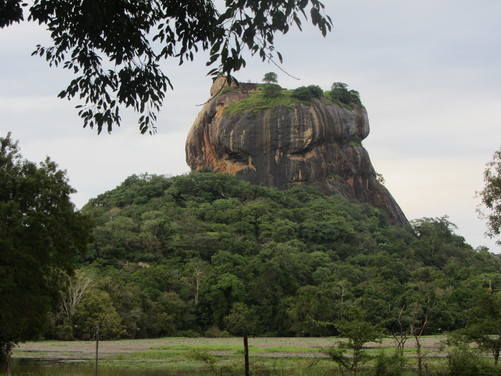
Apart from its sensational appearance, its claim to fame is that it was the citadel of nasty King Kassapa from 477 to 495, who usurped his brother’s throne, murdered his father and needed to hunker down somewhere impregnable. Legend has it that the ruins at the top of Sigiriya are the remains of his fortress-palace, though these days it’s acknowledged that they are more likely to have been a monastery. Halfway up the rock face beneath an inaccessible rocky overhang is a series of remarkable frescoes depicting unidentified female beauties.
This time I decided not to climb all the way up to the top. For a start, I’d done that twice already. I’m not masochistic enough to have to do it again ‘because it’s there.’ Pam had also been to the top previously, and she elected to stay down in the boulder garden at the foot of the rock. Margot and Heinz were determined to reach the summit. I made a compromise choice. I wanted to climb up to the frescoes and then carry on past the mirror wall to the Lion’s Paws. Then I would return to join Pam and explore the archaeological sites at the base.
Sigiriya posed one problem as far as I was concerned: the predators stationed at the top of the first few short flights of steps leading through the gardens to the base of the rock. Gangs of men wait there for foreign tourists and grab hold of them, to ‘help’ them up the steps. If you get caught by one you’re stuck with him all the way to the top and back down again, however much you attempt to shake the nuisance off. And this annoyance ends at the exit with an exorbitant demand for money.
My 1996 climb up the rock was blighted by one of these individuals, who tried to latch onto me. I told him firmly that I did not require help. Still he trailed me. I lost my temper, told him to go away, stayed back in the hope that he would go ahead, hurried on in the hope of putting distance between us. The message eventually got through, but he followed a couple of bends behind me during the whole of my climb. Back down at the base, sure enough, he demanded money for ‘helping’ me. He hadn’t helped me. I hadn’t allowed him to touch me. Not once. I refused to pay him. Much to my fury, my Sri Lankan brother-in-law forked out the money. He wanted to avoid a confrontation, he said.
I told Upali about this as we headed for the first flight of steps. I could see the gangs of ‘helpers’ waiting. I explained to Upali that my last experience had been so unpleasant that if any of these men attempted to grab me or to follow me I would not go up. Upali was my knight on a white charger. Whenever we came across groups waiting to pounce, he shouted ahead that under no circumstances were they to touch me. Quite what else he said to convince them to keep away from me – and by extension my three group members – I don’t know, but it worked. This time I could enjoy the climb unencumbered by unwanted attention.
I fail to understand how a UNESCO World Heritage site can allow this very unpleasant trade to exist. At the very least it should be properly regulated and policed.
Luckily our ploy to swap the Polunnaruwa and Sigiriya days around paid off. The rain stayed away as we headed through the symmetrically laid-out, rather bare water gardens towards the rock at 8.30 in the morning. We had decided to come early to avoid the midday heat during our climb.
Pam settled herself in the boulder garden – so called because of the giant boulders scattered at the rock base. She was intending to spend the time reading: Pam is rarely seen without a novel tucked into her bag. Waiting time is never wasted time as far as she is concerned – turn your back for a minute – nose in another novel. She brings a suitcase full – well, half a suitcase full, the other half being full of biscuits. Once she’s finished a book, she leaves it for the hotel. Now you can’t do THAT with your Kindle!
The remaining three of us began the slow steady climb up the rock. We were quite spread out and I was essentially on my own and could progress at my own speed. Yes, the steps are steep and narrow, but as long as you take them slowly and concentrate on where you are putting each foot, they are perfectly manageable, and are arranged in relatively short bursts with nice plateaux in between each flight where you can catch your breath while pretending to admire the view. How many are there? Difficult one to answer as reports vary but the consensus seems to be that there are around 1200 to the top, which would make about 900 to the Lion’s Paws. Oh yes, add another 100 or so for the vertical detour up to the frescoes, a spiral staircase in a wire cage – luckily one way only – one takes you up and another next to it leads you back down. You can see them in the photograph, leading off from the orange-coloured ‘Mirror Wall’, partway up the rock.
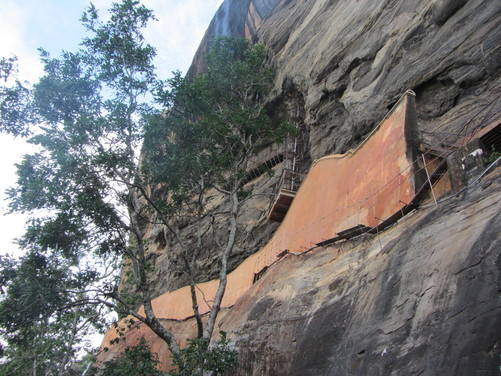
These frescoes of revealingly-clothed women are a marvel of the ancient world. They bear some resemblance in style to the famous Buddhist frescoes in the rock cut temples of Ajanta in Maharashtra, India, and indeed, they are thought to be from the same era – around the fifth century CE, when the Gupta dynasty ruled much of India. It was the Golden Age of Indian art and culture, and Gupta influence spread to far beyond India, including Sri Lanka.
The frescoes are amazingly fresh and vivid and a must-see. Along with the Buddhas of Gal Vihara in Polonnaruwa they are unofficial emblems representing the country. The women in the less revealing blouses are thought to be servants and those wearing tops that are so fine as to be transparent, princesses. It’s notable that the servants are generally darker-skinned than the royals. Possibly a case of local tribal women serving their high-caste Indian-origin mistresses.
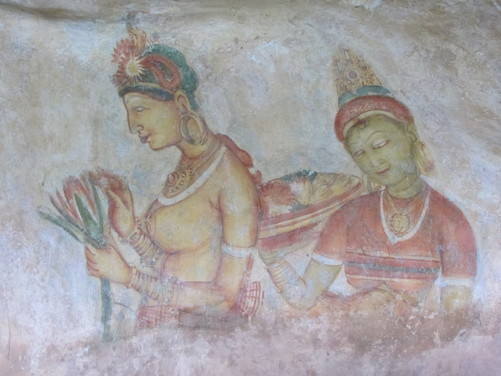
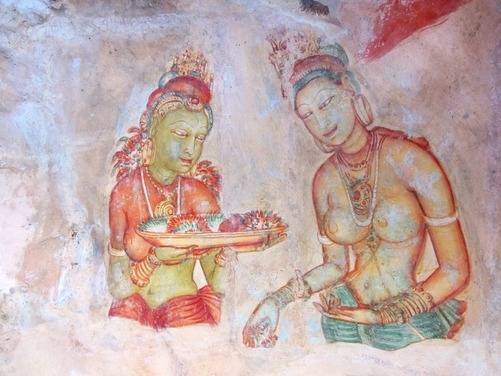
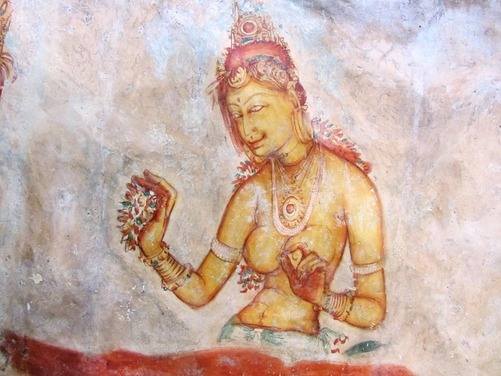
I climbed back down the spiral staircase, making sure I heeded the warning notice.
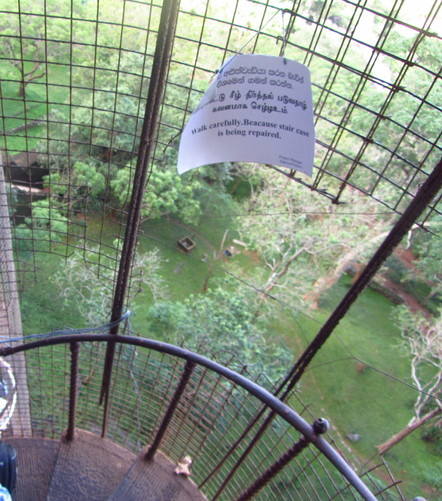
Then I carried on alongside the ‘Mirror Wall’, which is said to have been as shiny as a mirror when it was constructed, supposedly in the era of Kassapa. Medieval pilgrims etched their love poems and messages on it, so it became known as the ‘graffiti wall’ and was a source of much information to later art historians. The graffiti isn’t exactly obvious and when it’s pointed out by the guards protecting it, you’re likely to nod your head but probably, like me, you won’t be able to make out a thing among centuries worth of scratches and erosion.
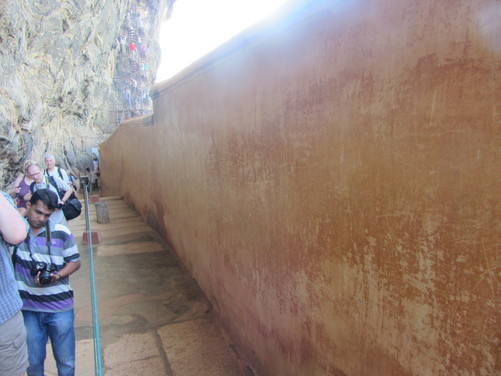
A further climb led me up to the Lion’s Paws, a flat platform behind which the rock soars upwards, metal stairways clinging onto it for the final ascent to the top. The first part of this last climb is another steep stairway, cut out of the rock between two gigantic sharp-clawed lion’s paws, all that remain of the lion, who also used to have a head, but this fell away long ago.
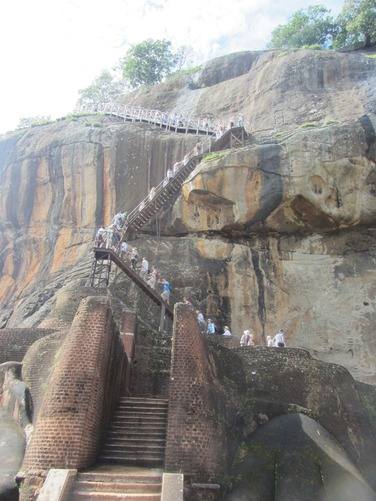
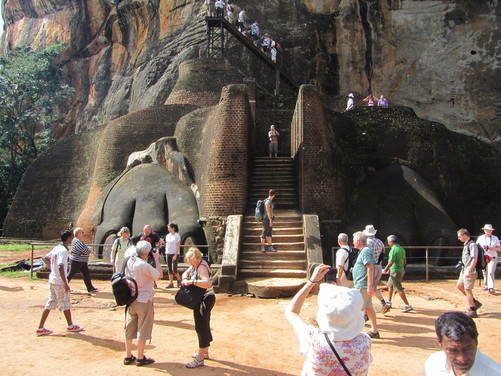
This is where I turned back. No amount of cajoling from Heinz and Margot could persuade me to go on. I wasn’t tired. There were simply other things I wanted to look at and, in any case, I had told Pam I’d be back and I was a bit concerned in case the pesty touts were annoying her.
I look my time, treading carefully and enjoying the view down onto the gardens and across the jungle to the hills surrounding Dambulla.
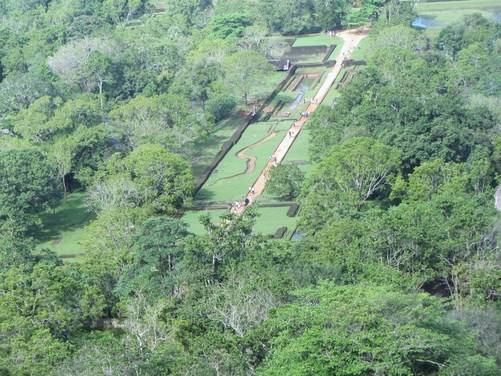
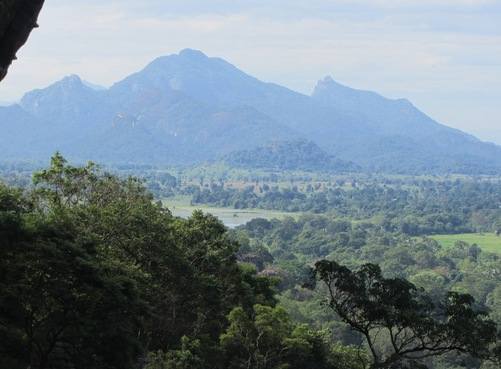
At the bottom of the rock, where the steps continued down into the garden, there was a parting of the ways, one path leading back to the boulder garden where Pam was waiting and another to the exit, where most tourists re-join their buses.
Here I encountered a succession of ‘helpers’ clearly unable to believe that I was of sound mind and body and was deliberately heading back the way I’d come in. I was stopped half a dozen times with the same message. ‘That way to the buses,’ pointing along the other path. By the sixth time I snapped back ungraciously, ‘thank you, I know where I’m going, I do not want the buses!’ By the time I found Pam, exactly where I’d left her, I had acquired a little group of these chaps, who kept their distance but were intent on following me, presumably to pounce when I eventually realised I was lost. They looked crestfallen when they realised I actually did know what I was doing.
We sat for a while, watching (and surreptitiously filming) the ‘helpers’ lurking at the top of the steps near us, choosing their prey. A young girl, an older woman, someone with a stick – you just knew they were going to grab an arm. You also knew what would happen next. The helped person would say thank you, thinking that was the end of the encounter. But no, once they’d grabbed the arm, they laid claim to the person, and off they went with the victim, who, I knew from experience, would be stuck with them for the duration and the encounter would end with unpleasant demands for money. In case you think I’m being unfair, try doing a bit of research online, or reading the Lonely Planet guide. This scam is infamous. The nuisances appeared to have a leader, a good-looking, long-haired young chap, who was watching and organising them, when he wasn’t glued to his mobile phone.
A French family came along, studied the ascent and decided that Grandpa, who looked very frail, wouldn’t be able to manage it. He was quite happy to wait there for them, just as Pam had done. Then his daughter made the mistake of saying that he needed a bottle of water. Immediately a couple of ‘helpers’ appeared. No water here, they told him, you have to go to the place where the buses wait. They pointed along a path with a wall at the end. We will help you.
The family went on their way, leaving Grandpa in the ‘safe’ hands of these two scoundrels. We watched, aghast, as, one on each side of him, they manoeuvred him along a very narrow, difficult path across the boulder garden. We couldn’t quite believe what happened then. When they reached the far side they propelled him up and over the old stone wall we’d seen, that separated the garden from the bus park. It was almost too disturbing to watch.
We decided to explore the boulder garden for a while, do a bit of lizard-spotting and then Margot and Heinz came down with Upali, so we made our way out through the water gardens, hoping the old man would return safely to where the family had left him.
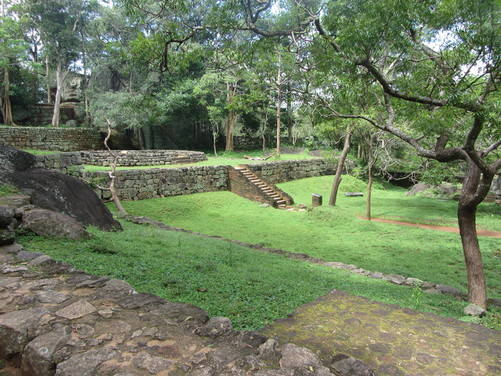
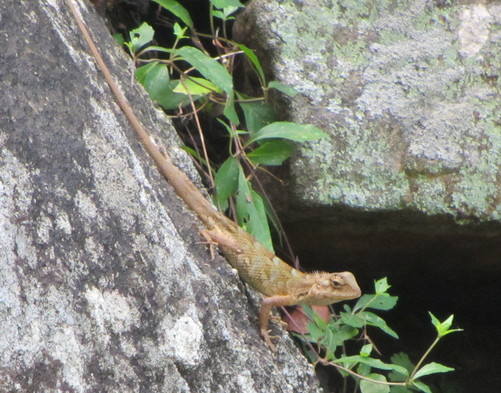
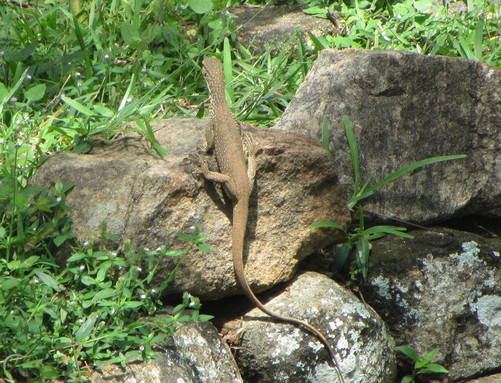
A short visit to the recently completed Sigiriya Museum followed. Very nice, but not quite the show-stopper the Lonely Planet Guide had led me to expect.
When we came out, it was around lunch time. No problem, we had the usual supply of delicious little bananas filched from the breakfast buffet. We weren’t going to waste precious time with a sit-down meal. But what now? Upali had suggested a ‘village safari’ but that turned out to be expensive and sounded rather like a round of ‘shops’ disguised as local crafts.
I know, I said. Let’s go to Dambulla. I’d been secretly worried. Upali had said we could stop at Dambulla on the way to Kandy when we left Sigiriya next day. I’d mulled it over and decided it wouldn’t work. Not if we were to have time to do the magnificent cave temples justice and then arrive in Kandy with enough time to visit the Peradeniya Botanical Gardens and do them justice. Dambulla is only 9 miles from Sigiriya and, much to my relief (my group is volatile) my suggestion was greeted with unanimous enthusiasm. Well, not quite unanimous. Upali was aghast. He’d been worried about us climbing Sigiriya and Dambulla on consecutive days, now we were planning to do both climbs on the same day.
We, however, insisted, and there was little he could do about it except look shocked! So we piled back into the van and headed off to our next adventure.

Add a comment: